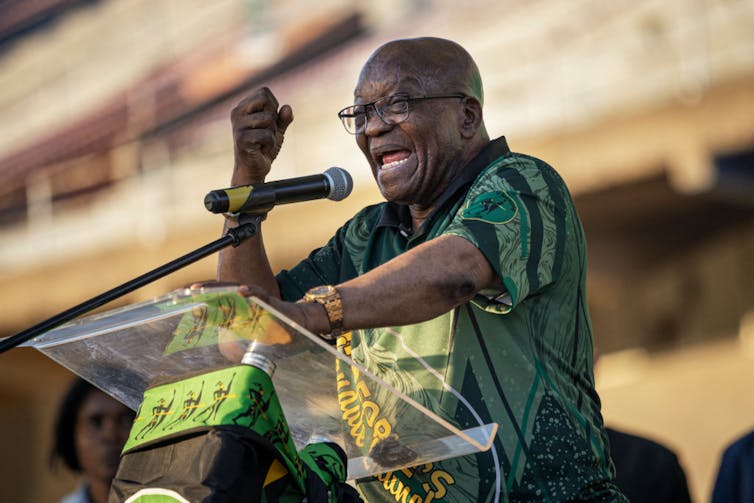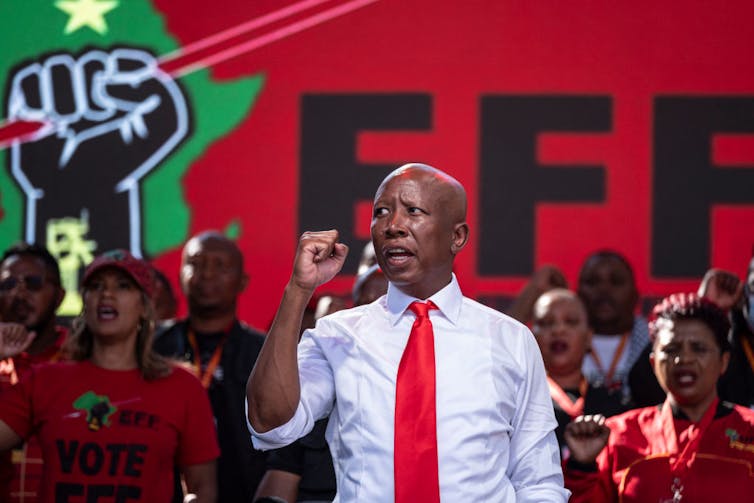The African National Congress (ANC), the party that’s led South Africa since the first democratic elections in 1994, has long considered itself a “liberation movement” – representing all South Africans, as the “voice of the people”.
But its dismal performance in the 2024 elections (winning only 40% of the national vote) confirms that its transition from the status of a liberation movement to just a political party is now complete. There can no longer be a pretence that it alone represents “the people”. It is now simply the largest among a host of ordinary political parties doing what ordinary political parties do: scrambling for votes, political power and influence.
I have studied the ANC since the days of the liberation struggle and as a party in power.
In reality, any notion of the ANC embodying the people has been creaking for years. Those at odds with its leadership have peeled away to found new political parties. First there was Bantu Holomisa, who fell out with Nelson Mandela in 1996. More recently, in 2012, Julius Malema was expelled after supposedly bringing the ANC into disrepute. Malema founded the Economic Freedom Fighters to fight the election in 2014.
Only the Economic Freedom Fighters was to gain much political traction. But the message was clear: the coalition on which the ANC was based was becoming ever more fragile and could not last.
Hence the historical significance of the electoral eruption of the uMkhonto we Sizwe Party (MK Party) of Jacob Zuma, former president of both the ANC and South Africa. Prior to the 2024 election, Zuma’s party was widely recognised as representing a threat to ANC hegemony, both nationally and provincially in KwaZulu-Natal. But the strength of its performance has taken South Africa (and the party itself) aback.
Within six months, and with only the rudiments of organisation stolen from the ANC itself, it has taken 14.5% of the national votes and 45% of the KwaZulu-Natal votes in its first election.
Few can dispute that its rise is the most dramatic stage in the dissolution of the coalition which gave the ANC a claim to being a liberation movement.
The making of a liberation movement
The ANC’s claim goes back to its foundation in 1912. It was a reaction to the formation of the Union of South Africa by white politicians and their exclusion of the majority black people from the right to vote or participate on equal terms with whites.
At its creation, the ANC (or the South African Native National Congress, as it was known until 1923) was the coming together of South Africa’s black and Coloured population (in the old terminology): its diverse ethnic peoples, their chiefly representatives and the emerging African professionals and black middle class.
This culminated decades later in its leadership of the Congress Alliance, the bringing together of the ANC with the South African Indian Congress, the Coloured People’s Congress and the (largely white) Congress of Democrats.

The ANC’s predominance among those fighting apartheid was to be briefly challenged by the breakaway of the Africanists grouped together as the Pan-Africanist Congress in 1959. But the threat dissipated during the long years of exile as the Pan-Africanist Congress collapsed into factionalism.
By the early 1990s, via its alliance with the South African Communist Party, and under the leadership of Nelson Mandela, the ANC could put forth a highly plausible claim to be the genuine representative of “the people”. By this it meant the overwhelming majority of South Africans, of diverse colours and backgrounds, who were bound together by a commitment to “non-racialism” and who were oppressed by apartheid. This was confirmed by the ANC’s performance in the 1994 election: 63% of the vote.
It could say that the non-racial and democratic South Africa which had emerged from the negotiation process with the apartheid regime was essentially the product of its own vision and imagination.
If any movement could lay claim to having “liberated” South Africa, it was the ANC. However, while aspiring to unity, the ANC was never a monolith. Indeed, it was precisely because it was always a coalescence of diverse tendencies, notably of communists and non-communists, and of “Africanists” and those committed to “non-racialism”, that so much importance was attached to the notion of its being a “liberation movement”.
A political party was seen as just that: a grouping which represented just a “part” of the people. In contrast, the ANC was presented and viewed itself as embodying the essence of the people, the soul of the nation, and as capable of reconciling differences which might otherwise blow a historically and racially divided nation apart. It followed that those who opposed it were divisive.
In other words, there was always a tension at the heart of the ANC’s notion of democracy. It was always a difficult balancing act. At one moment, it celebrated the diversity and plurality which found its form in a new constitution which was largely based on the tenets of liberal democracy. At another, it insisted on the unity of the nation under its own leadership, which was distinctly illiberal, even totalitarian.
Liberal democracy presumed that the ANC’s leadership of the nation could be displaced at an election. But the alternative notion of democracy suggested that it could not. If the ANC was “the people”, how could “the people” overthrow the ANC?
The ANC has lost ground, but the tradition lives on
At its height, reached in the 2004 election, the ANC swept just under 69.7% of the total vote. With Holomisa’s United Democratic Movement winning 2.3%, the total vote for parties representing the historical tradition of the ANC amounted to 71%.
In the 2013 election, the total vote for the ANC tradition, made up of the ANC (62.15%), Economic Freedom Fighters (6.35%) and United Democratic Movement (1%), amounted to 69.5%. In 2019, the combined vote for the ANC (57.5%) and Economic Freedom Fighters (10.8%) remained much the same, at 68.3%. So it remains in 2024, with the combined vote for the ANC (40.18%), Economic Freedom Fighters (9.52%) and uMkhonto we Sizwe (14.59%) coming in at 64.3%.

In short, the ANC tradition remains dominant, but the ANC as a liberation movement does not.
Herein lies much of the significance of the 2024 election. It is the ANC that has lost ground, not the ANC tradition. What has become divided could reunite. Or more likely, bits of it could reunite.
The faultline
A commitment to the form and values of the constitution is becoming the major fault-line in South Africa’s politics, opening the potential for an alliance between uMkhonto we Sizwe, Economic Freedom Fighters and the remnants of the “radical economic transformation” faction within the ANC.
The more that looms, the greater the possibilities for a coming together of the constitutional element within the ANC, a progressive bloc within the main opposition Democratic Alliance, and other parties, the old (Inkatha Freedom Party) and the new, such as Rise Mzansi, which are committed to the values of 1994.
Never has the future of South Africa’s politics been more uncertain, but the one certainty that holds is that the ANC’s standing as a liberation movement is dead. In effect, there are now two ANCs: the ANC of current leader Cyril Ramaphosa, and the ANC of Jacob Zuma and Julius Malema. They cannot both claim to represent “the people”.

